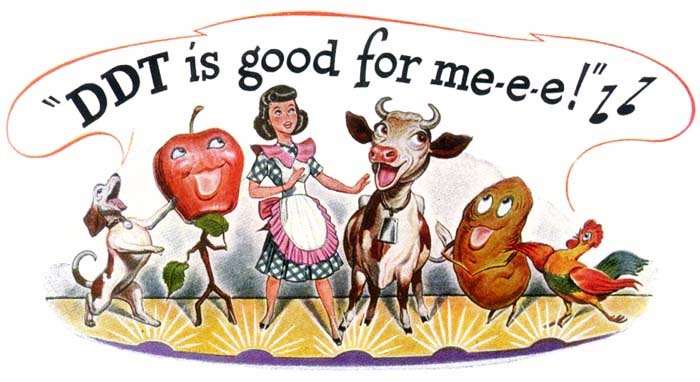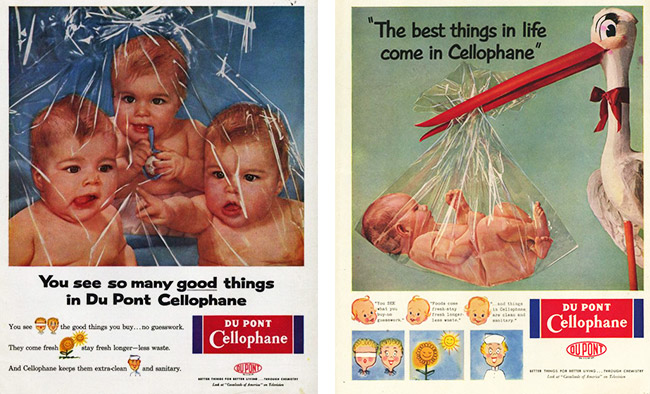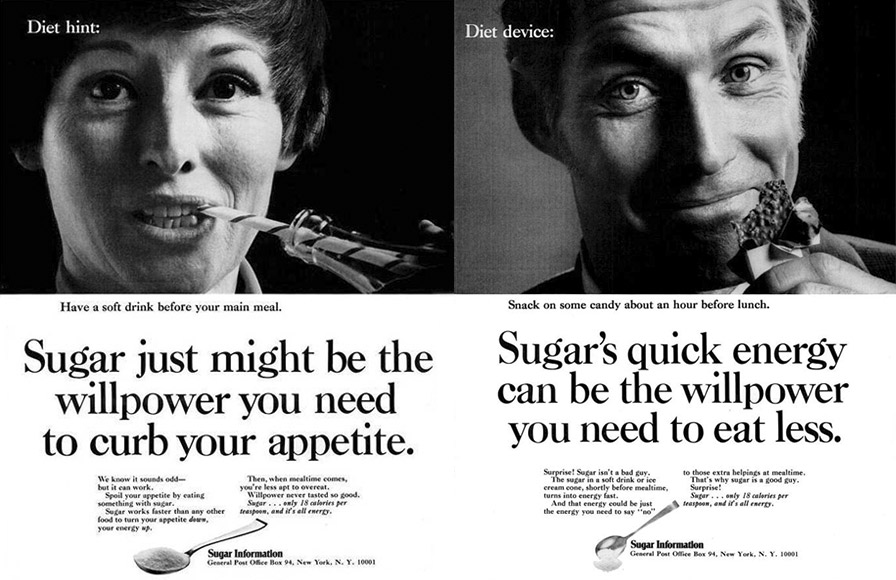https://youtu.be/oyl22QQOU4M
Sent from my iPad
What Were We Thinking? The Top 10 Most Dangerous Ads
Often the criticism of vintage ads focuses on their inherent sexism, racism, or other displays of social prejudices, which we find laughable today, despite their continued presence. But what about ads that steered consumers into dangerous territory, espousing outmoded scientific evidence or misleading half-truths to convince people that appallingly toxic products, or even deadly ones, were actually good for them?
While some faulty campaigns were merely the victims of evolving scientific knowledge, many blatantly ignored facts in their race for the dollar, using so-called experts to promote products terrible for public health, like cigarettes. Revered professionals like doctors and scientists routinely told us precisely the wrong things to do, as they are likely still doing today.
"Diet Hint: Sugar might just be the willpower you need to curb your appetite."
We may take comfort in feeling we're far beyond the bad old days of deceptive advertising, but our current obesity epidemic suggests exactly the opposite: We've simply traded effects like lung cancer and emphysema for diabetes and heart disease.
So here's a look back at 10 colossally painful advertisements, which make you wonder: What modern "health" products – vitamin water, granola bars, acai berry supplements – might look a little more evil in the future?
1. Junk Food, Now Fortified with Vitamins and Minerals
Disguising empty calories with healthful nutritional values has been a trope of the processed food world ever since vitamins were first discovered in the 1910s. This 1942 poster for "Vitamin Donuts" may be a little hard to swallow today, but Ovaltine's reputation as a health drink is still being disputed, a powerful testament to simple brand positioning. But let's be real, we're talking about powdered chocolate milk made by Nestlé, the company who brought us such healthy foods as Butterfinger candy bars and Häagen-Dazs ice cream.
The Ovaltine ad from 1947 still boggles the mind with its display of so many nutritional perks packed into two glasses of powdered milk, and seems eerily similar to the many supposed benefits contained in drinks like Vitamin Water or Gatorade. In reality, even the benefits of ordinary vitamin supplements are now being questioned, despite the fact that around half of American adults take them regularly.
2. Let Them Eat Lead
The most heartbreaking part of this 1923 brochure is its emphasis on kids having fun with the whole "Lead Family" of products, whose presence in everything from their nursery walls to their windup toys made young children particularly susceptible to its dangers. Combined with lead paint's seductively sweet flavor, putting kids in environments literally covered with the stuff was a recipe for disaster.
In fact, the effects of lead poisoning (brain damage, seizures, hypertension, etc.) were known long before the Consumer Product Safety Commission finally banned them in 1977; the industry had simply refused to acknowledge them. An article by Jack Lewis published in the EPA Journal in 1985 covers lead's history as an additive and poison, and how we've consistently downplayed its adverse effects. Lewis writes:
"The Romans were aware that lead could cause serious health problems, even madness and death. However, they were so fond of its diverse uses that they minimized the hazards it posed. Romans of yesteryear, like Americans of today, equated limited exposure to lead with limited risk."
3. 7-Up is for Babies
Not only were sugary soft-drinks great for adults, but sodas like 7-Up used to help babies grow up strong and fit, or so these ads from 1955 and 1953 would have you believe. That's pretty disturbing, considering that childhood obesity, linked arm-in-arm with massive soda intake, is shortening our youngest generation's lifespan. The high amount of refined sugar in soda has also been shown to be particularly harmful for children.
Today it seems crazy to show a baby drinking a soda, as the tide finally turns against the sugary drinks: School districts across the nation have removed soda machines from their schools and New York City's Board of Health has proposed a ban on over-sized sodas. However, many adults today opt to serve kids "healthy" fruit juice, which may be just as bad, despite its deceptive nutritional marketing.
4. Cigarettes: Just What the Doctor Ordered
Camel's campaign featuring doctor endorsements is probably the most familiar instance of false advertising, seen here in an ad from 1948. Yet almost every cigarette company twisted science to support its products, including Chesterfield's 1953 ads, which rephrased expert findings to show that smoking had "no adverse effect." Long after 1950, when Morton Levin published his definitive study linking smoking to lung cancer, experts continued to imply that there were other factors causing cancer and lung disease.
Though the industry has been seriously weakened over the past 20 years, primarily by government regulation, Big Tobacco is still issuing misleading health information in an attempt to reap a profit.
5. Feminine Hygiene: The Original Home Wrecker
Long before Lysol was reinvented as the caustic household cleaner we know today, the same substance was basically promoted for use as a feminine hygiene product. These Lysol ads from 1948 tout the internal use of poisonous Lysol as a marriage saver. To sum up the message: if you weren't so dirty down there, he would love you more.
In a time when speaking about sex was even more frowned upon than today, a whole spectrum of sexual products, including vibrators and contraceptives, was marketed with campaigns focusing on their dubious health benefits for women.
6. Plastics, Plastics, Everywhere
Suffocating babies in Cellophane! A bunch of infants tied up in clear cellophane packaging is pretty frightening to modern viewers, but at the time, these ads were just plain cute. When these Du Pont Cellophane ads came out in 1954, things like plastic grocery bags weren't a ubiquitous part of American culture. Only after plastic bags became widespread during the 1970s did their strangulating qualities become frighteningly clear.
7. The Meat Mystery
In post-World War II America, eating more red meat seemed like a great way to keep yourself "in trim," at least according to these two ads, from 1956 and 1946. Like other food fads, this campaign was orchestrated by the American Meat Institute, a lobbying group that is still working to improve public and political opinion toward its products. Maybe that's why almost nobody in America knows that nutritionists generally recommend only 2-3 servings of red meat per week. And don't get the experts started on sodium nitrite in processed meat.
We now know that eating too much meat increases the risk of heart disease and cancer. Yet industry trade groups are still creating food trends to spur sales or combat negative public stereotypes: Think of modern wonder-foods like agave nectar or chia seeds that seemed to appear from the heavens, as well as the bitterly argued corn syrup campaign.
8. Dieting? Try Sugar
In a time before the current widespread obesity epidemic, sugar companies wanted shoppers to believe that a sweet treat would somehow inspire you to eat less. These ads from 1969 coach readers to "have a soft drink before your main meal" or "snack on some candy an hour before lunch." Their strange logic isn't even backed by a company name, though the campaign does include a helpful mailing address for "Sugar Information." Talk about creepy.
Now refined sugar is presented as the dieter's enemy, and is thought to make you want to eat more rather than less.
9. Shock Your Way to Physical Perfection
In 1922, "Violet Rays" were said to cure pretty much anything that ailed you. This Vi-Rex device plugged into a light socket so users could give themselves home shock-treatments, which would supposedly make you "vital, compelling, and magnetic." Various recalls and lawsuits erupted throughout the U.S., forcing the FDA to finally prohibit their manufacture. The last batch of Violet Ray products was seized in 1951.
Just Google "light therapy" to find a range of new infrared devices whose claims to prevent everything from aging to anxiety sound pretty darn familiar.
10. DDT For You and Me

This ad for "Penn Salt Chemicals" from 1947 shows a range of dangerous applications for now-illegal DDT, from agricultural sprays to household pesticides. Particularly disturbing is the image of a mother and infant, above the caption stating that DDT "helps make healthier, more comfortable homes." Not quite.
While effective in eliminating dangerous mosquitoes that carry malaria, DDT also has a variety of hazardous effects: Especially among young children, the chemical has been shown to damage the nervous, immune, endocrine, and neurological systems, not to mention its devastating influence on the natural environment. The spread of DDT across mid-century America is mirrored today by the success of Monsanto (one of the companies that originally manufactured DDT) in placing its genetically modified products on store shelves before researchers have a full understanding of their larger ecological impacts.






















